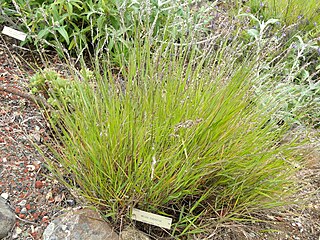Melica argyrea is a species of grass found in Argentina, Brazil, and Uruguay.
Melica argentata is a species of grass endemic to Chile.
Melica longiflora is a grass species in the family Poaceae that is endemic to Chile where it can be found from Coquimbo to Talca.
Melica bonariensis is a species of grass endemic to Argentina where it can be found in such provinces as Buenos Aires, La Pampa, and Rio Negro.
Melica brasiliana, is a grass species in the family Poaceae that is endemic to Brazil and southern South America.
Melica turczaninowiana, is a species of grass found in Mongolia, North Korea, Russia (Siberia), and China.
Melica yajiangensis, is a species of grass that is endemic to China.

Melica teneriffae, is a grass species in the family Poaceae that is endemic to the Canary Islands.
Melica spartinoides, is a species of grass in the family Poaceae that is endemic to the Brazilian state of Santa Catarina.
Melica porteri, known as Porter's melicgrass, is a species of grass that grows in the United States and Mexico. In the US it is found in Arizona, Colorado, Kansas, New Mexico, Texas, Utah, and Iowa.
Melica eremophila is a species of grass that is native to South America.
Melica glabrescens is a species of grass found in Buenos Aires and Río Negro, Argentina.
Melica lilloi is a species of grass found in Catamarca and Tucumán provinces of Argentina at 3,200–3,500 metres (10,500–11,500 ft) above sea level.
Melica kozlovii is a species of grass found on mountain slopes in Mongolia and China at 2,000–3,900 metres (6,600–12,800 ft) above sea level.
Melica paulsenii is a species of grass endemic to Chile where it grows along the coastal cordillera at 50–700 metres (160–2,300 ft) above sea level.
Melica mollis is a species of grass endemic to Chile where it grows in rock crevices at 340 metres (1,120 ft) above sea level.
Melica rigida is a species of grass found in Argentina, Brazil, and Uruguay.
Melica patagonica is a species of grass that is endemic to South America.
Melica parodiana is a species of grass found in Buenos Aires, Argentina and Uruguay.
Melica radula is a species of grass endemic to China. It grows on grassy mountain slopes and larch forests at 300–1,200 metres (980–3,940 ft) above sea level.
